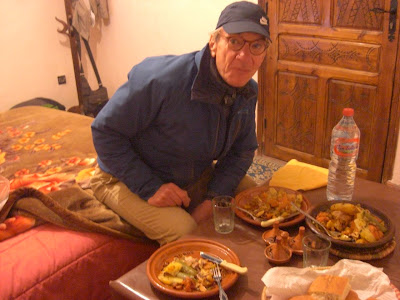 |
| Asilah medina sunset colors |
 |
| Asilah medina before daybreak |
When I arrived in Asilah, I thought the
medina was beautiful but also foreign and forbidding. My feeling of not belonging was so strong that I didn't dare to go out by myself. I soon came to realize that as a Westerner, I'm not an anomaly. Tourists come here by the busloads. But I'm not a local, either, and I don't pretend to understand what lies beneath the surface.
 |
| Portal of the Raissouni Palace, home of an infamous Asilah pirate in the early 1900's |
Medinas in Moroccan cities were the original towns, often surrounded by walls. Eventually a city would have to expand outside the walls, leaving the centuries-old medina as a living history museum.
 |
| A cart transports goods along the medina wall. |
Especially, after France negotiated the right to "protect" Morocco in 1912, the new French residents found the chaotic medinas too messy for their taste. They established "villes nouvelles"--new towns--outside the medina with wide, straight avenues and updated conveniences.
 |
| Asilah Ville Nouvelle |
After Morocco regained independence in 1956, many wealthier Moroccans found the villes nouvelles more to their liking and moved out of the medinas, which ironically are now being gentrified by non-Moroccans, especially the French.
 |
| A gentrified cul-de-sac in the Asilah medina |
The medinas remain as microcosms of Moroccan culture. The Asilah medina is small but it has most of the elements of a self-contained town:
little grocery stores called "hanouts", also tailors, clothing stores and jewelry and crafts bazaars;
 |
| Clothing for sale. The grocery in the foreground is closed. |
 |
| Carpets for sale in the main square |
mosques, shrines, and schools;
 |
| One of 5 mosques in the Asilah medina |
 |
| The medina "medersa", an elementary school |
 |
| Mausoleum and cemetery |
a communal oven (ferran) and a communal bath (hammam);
 |
| Hammam in the Asilah medina, with wood supply (for heating) at the entrance |
 |
| A girl takes bread to be baked at the communal oven, Asilah medina. |
 |
| Baked bread (khobz) awaiting pick-up at a communal oven in Fes |
a few workshops in pottery, wood, leather, and calligraphy (but nothing like what you find in the huge medinas of Fez and Marrakech);
and lots of residences in the form of townhouses. From the outside, it's hard to tell what's inside.
 |
| Some colorful medina doors |
 |
| A gated compound. Not all the houses have been gentrified. |
There's a fresh food market along the medina wall just outside the Bab Homar, one of the main gates.
The Asilah medina benefits from a cultural festival that's held every summer, when artists paint murals on the white-washed walls. Visiting artists come from all over Morocco and around the world, and have spurred the proliferation of local artists and galleries in the medina.
 |
| Festival poster from 2000 |
 |
| 2012 mural |
 |
| A painter works on his gallery. |
 |
| One of the medina's most persistent itinerant salesmen. He can sell you his art in a dozen languages. |
Asilah is also notable for the efforts taken to keep the medina clean.
 |
| Medina street sweepers wearing traditional hats from the Rif mountains |



































































